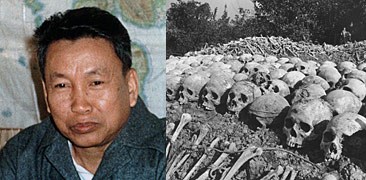When and where it occurred: Cambodia, between 1975 and 1979 (Wiki, para 1).
Who was involved: The perpetrators were Communist guerilla organization Khmer Rouge, led by infamous dictator Pol Pot (Wiki, para 1). They killed anyone who failed to work or comply for the Khmer Rouge’s benefit, which included the religious, the Western, and the unable (World Without  Genocide, paras 12, 13).
Genocide, paras 12, 13).
What happened: To understand the Cambodian genocide, one must understand the political landscape that led up to it. In 1970, General Lon Nol deposed French-installed Prince Sihanouk, prompting the prince and his followers to defect to the Khmer Rouge (WWG, para 4). In 1975, after Cambodia was ravaged by the Vietnam War, the Khmer Rouge under Pol Pot seized control of Cambodia after a bloody civil war (WWG, para 6).
Pol Pot built his vision of Cambodia on Mao Zedong’s Communist policies in China (WWG, para 9). By the time of his takeover, the Khmer Rouge had swelled to 700,000 mostly uneducated teenaged boys – an army willing to do Pol’s bidding without conscience or scruple (WWG, para 8). The government instantly seized all property, shutting down schools, hospitals, and churches (WWG, para 8). Then the executions began. Anyone religious was killed; all professional persons in any field were killed; anyone remotely connected to a Western influence were killed, as were their entire families. (PPU, pg. 2, para 3). Showing emotion was forbidden (WWG, para 12), and simply laughing or crying could get you shot (PPU, pg. 2, para 3).
Pol Pot wanted to create in Cambodia an agrarian society where every citizen participated in collective farms in complete absence of Western influence (WWG, para 10). Thus were the killing fields born. All those unable to work – the old, sick, or too young – were killed (PPU, pg. 2, para 2). Those who survived the mass executions were removed from their homes and put to brutal unpaid work in conditions rampant with starvation, disease, and unspeakable brutality (PPU, pg. 2, para 3). Human life was worthless to the Khmer Rouge. It is estimated that from as many as 3.3 million people were killed under their reign of terror, with 650,000 dying in the year following their downfall (WWG, para 16). This number constituted a quarter of the national population of Cambodia, ensuring Pol Pot’s name alongside that of Hitler and Stalin.
The Khmer Rouge was destroyed by the Vietnamese army (PPU, pg. 3, para 1). Wary of Vietnamese domination of Indochina, Pol Pot lashed out against Vietnam in a preemptive attack, exterminating over 100,000 Vietnamese civilians and launching military actions on the border (Wiki, para 16) . This led to a three year war, which culminated in December 1978, when Vietnamese leaders decided to invade Cambodia and remove the Khmer Rouge from power (Wiki, para 17). 150,000 troops overthrew Pol Pot’s regime in just two weeks, effectively ending the Cambodian genocide (Wiki, para 17).
Pol Pot died on April 15, 1998, under house arrest. He was 72. (Wiki, para 2)
_____________________
Works Cited:
- Peace Pledge Union: Talking About Genocide: Cambodia – http://www.ppu.org.uk/genocide/g_cambodia1.html.%20Retrieved:
- Wikipedia: Khmer Rouge – https://en.wikipedia.org/wiki/Khmer_Rouge.
- World Without Genocide: Cambodian Genocide – http://worldwithoutgenocide.org/genocides-and-conflicts/cambodian-genocide.
